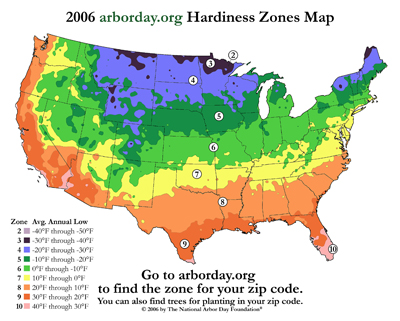Bamboo Hardiness Zones
The hardiness map below will help you determine which bamboos will grow well in your local climate. Hardiness zones are used to predict the lowest temperatures your region is capable of producing. Click on the map to enlarge it. You can also enter your zip code to see which zone your city or town falls under. This is an excellent resource and an essential first step for before growing bamboo.
This bamboo hardiness chart has been provided courtesy of the Arbor Day Foundation. Check out their website at www.arborday.org. They provide a vast amount of resources for bamboo growers on their website.
What is a Hardiness Zone?
A hardiness zone is a geographically defined area in which specific types of plants are capable of growing based on the annual minimum temperature. The different zones on the map below are determined by averaging the lowest recorded temperatures of each winter season. For example, if five successive winters reach respective minimum temperatures of −12 °C, −14 °C, −10 °C, −14 °C, and −13 °C, the mean coldest temperature is −12.6 °C. It is also a good idea to use other local plants as an indicator of hardiness. If Golden Goddess bamboo is growing in the garden next door, it is safe to asume that it will grow in your garden as well.
Knowing the extremes of winter in your area is a major determining factor when planting bamboo, but keep in mind that it is not the only aspect to consider. Soil, placement, wind, sunlight and other topics will need to be considered before planting. Be sure to take a look at the bamboo growing guide to gain a full understanding.

